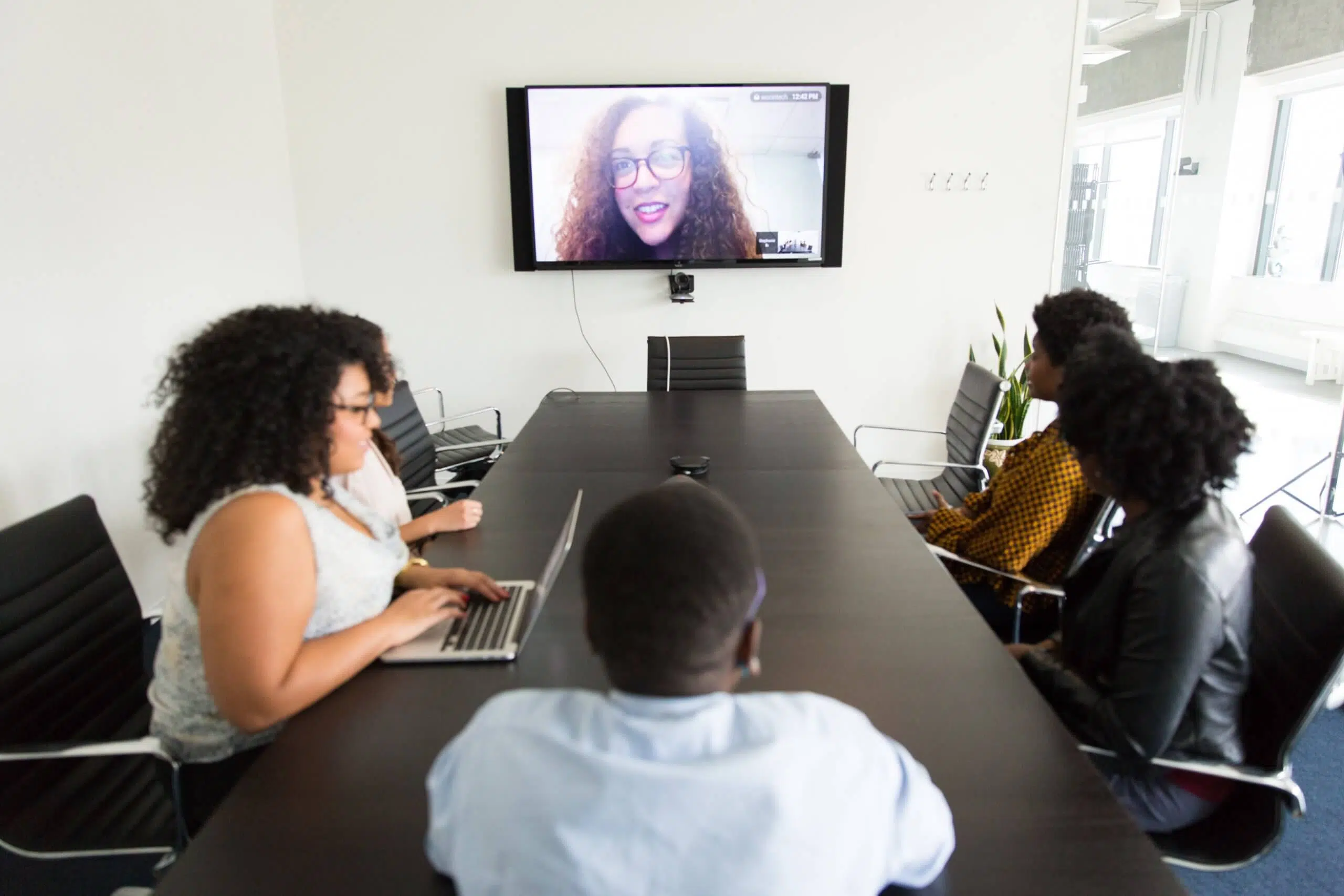As Benjamin Franklin’s famous phrase goes, “Time is money.” Meetings are expensive, costing both your people their time and your company money. In fact, the average organization can spend up to $1,176 per week for each of their managers to attend meetings, a cost that only goes up as seniority increases. When done right, meetings can spur connection, progress, and innovation in teams. However, running a productive meeting is no easy feat, and inadequate organization can leave your team wondering if this “could have just been an email.”
As offices slowly and safely reopen, many organizations will begin running their first hybrid meetings with participants in-office and online. These meetings will set the tone for hybrid meetings for years to come, determining whether the thousands of dollars spent on meetings each week will be losses or investments. Therefore, knowing how to run a great meeting that is engaging and inclusive — while allowing for clear communication and decision-making — is a clear competitive advantage.
That said, running a great hybrid meeting takes more than just putting the skills of running in-person and virtual meetings together. Hybrid meetings come with their own set of challenges that your company will need to navigate. For example:
- Technological barriers. Technology can make it disproportionately difficult for virtual participants to participate in conversations, making them unable to share their ideas and stifling innovation.
- Feelings of exclusion, leading to ineffective meetings and disengagement. Virtual participants may feel excluded since they are not physically with the team, which may hurt their engagement with meetings and their work.
- Competing audiences, giving rise to workplace friction. There are now two “audiences”: one in-person and one virtual, each with their own needs and environments, which can give rise to misunderstandings between attendees.
To help you and your people tackle these challenges head-on, we’ve put together this hybrid meeting guide.
Break Down Technological Barriers in a Hybrid Workplace
Lights, camera, action
Don’t underestimate the power of crisp audio, clear visuals, and strong lighting.
- For great audio quality, invest in a conference microphone (or set of microphones) that is designed to capture audio for an entire room. If you have a big team, consider investing in an audio mixer to create uniform audio for remote participants.
- A simple way to up your camera game is to create a three-dimensional view of the room by using hardware that automatically focuses on the speaker. The Meeting Owl is a popular option; if you have smaller co-located teams or a smaller budget, alternatives like the Logitech BCC950 might also be a good fit.
- Ensure in-person participants are well-lit. Watch out for backlighting – a light source directly behind participants makes it difficult for remote employees to see who is talking.
Invest in digital collaboration software
If your organization isn’t using online visualization software, it’s time to start. In a hybrid meeting, remote employees won’t be able to see physical whiteboards or collaborate on paper with their in-person colleagues. An easy fix to this problem is to use an online whiteboard like Miro to help you brainstorm as a team. Miro, in particular, can help boost creativity and participation since contributors can be kept anonymous.
Be prepared for failure
Even with intensive planning and set-up, sometimes things won’t go as planned. Train your people to meet these challenges with remote colleagues in mind. For example, if you experience technical difficulties, don’t just continue the meeting with in-person participants, as this sends remote employees the message that they are not a crucial part of the team. Instead, consider continuing the discussion asynchronously or, if unavoidable, record and transcribe the meeting with a solution like Otter so that remote participants are up-to-date on anything they missed.

Create Engaging and Effective Hybrid Meetings
Create connection and trust through icebreakers
Research at the Zak Lab has shown that forming genuine connections at work boosts employee performance. So beyond covering the items on your meeting agenda, make time for your employees to connect. At Hone, we begin team meetings with an icebreaker that helps us get to know each other. These icebreakers range from “What was your dream job as a child?” to “What’s your preferred way to eat a potato?”
To make space for deeper conversation, your organization can also start meetings by asking each person to share their highs and lows for the week, and how their team members can be of support. Setting aside those first few minutes of a meeting and giving your employees the opportunity to connect can go a long way in terms of improving team trust, performance, and engagement.
Stay organized with an agenda
While allotting time at the beginning of meetings to form connections is important, it is equally important to direct focus on the meeting goal after this socialization period. A recent survey found that one of employee’s top three pet peeves with meetings is a lack of preparedness; to combat this, here are a few meeting agenda templates to get you started.
For added transparency, train your people to create and send out agendas ahead of time so participants know if they need to come prepared to present, brainstorm, or discuss. And at the end of every meeting, make sure tangible next steps and task ownership are discussed so everyone leaves with a clear understanding of what they need to do.
Keep engagement top of mind
To keep meeting participants engaged, train your people to create space for discussion during the meeting as well. This can include asking specific employees to share their thoughts on the matter at hand, asking different individuals to present or lead specific sections of the agenda, or just leaving time for questions.

Build Empathy for Different Audiences
Share meeting ownership
Hybrid means that there are multiple ways to experience the same meeting. The simple process of gauging when to jump into a conversation takes on very different forms, with co-located participants more attuned to short pauses than those attending remotely. With these nuanced differences, it is likely that blind spots – parts of the other groups’ experience that you cannot perceive, and thus cannot address or plan for – will emerge. A great way to overcome these blind spots is to rotate meeting planning responsibilities over time so that both in-person and remote employees have the ability to shape what the hybrid meeting looks like.
Seek regular feedback and encourage reflection
“Team reflexivity” is when teams pause to reflect and communicate on their work, which can help improve collaboration and a team’s ability to achieve its goals. On the other hand, teams that lack this ongoing communication are often fraught with misunderstandings and judgments that can hamper teamwork and productivity.
How might this take form on a hybrid team? Thanks to physical distance and technological limitations, it’s common for in-person employees to feel like remote employees are not engaged and participating enough in hybrid meetings, while those same remote employees feel like their opinion is not valued and their engagement is unimportant to the co-located team members. To ensure these interpretations are addressed before they become a source of tension, make sure your people assign 5-10 minutes at the end of team meetings (or during 1-on-1s) to talk about how the meeting went, and explicitly ask if remote employees feel sufficiently included. As your organization sets the norms for hybrid meetings, facilitating empathetic and vulnerable conversions will help you create a team culture that helps everyone feel valued, appreciated, and seen, regardless of where they work.
Monitor bias towards remote employees
With part of your organization in the office and part at home, your managers need to take extra care to ensure teams don’t develop an “us vs. them” mentality. Oftentimes, in-person employees are subconsciously equating physical presence with engagement, an unconscious belief known as proximity bias. In order to lead successful hybrid meetings, you need to manage these biases so that contributions from remote and in-person employees are valued equally. A great way to manage proximity bias is to rewatch recorded meetings or look back at transcripts as you are reviewing employee performance instead of relying on your memory to accurately evaluate contributions.














